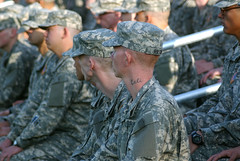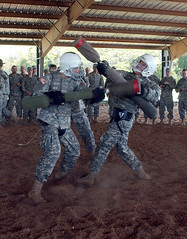This morning, the 2nd Battalion, 46th Infantry Regiment -- a basic training unit on Fort Knox -- hosted a media day to demonstrate the changes that have been made to the basic training regimen and philosophy. Yours truly got tagged to cover it for our paper, and to shoot photos for our parent publication in Elizabethtown. Our first stop was Victory Field, where some Day Zero recruits were sitting in bleachers, preparing to meet the drill sergeants who would be "guiding" them through the next nine weeks. It was a sober affair -- none of the screaming and yelling that may have gone on in years past. The company first sergeant stood behind a podium in front of the four platoons and read the new guys some of the history of the 46th... battles won, campaigns fought, reactivation as a training unit.
Our first stop was Victory Field, where some Day Zero recruits were sitting in bleachers, preparing to meet the drill sergeants who would be "guiding" them through the next nine weeks. It was a sober affair -- none of the screaming and yelling that may have gone on in years past. The company first sergeant stood behind a podium in front of the four platoons and read the new guys some of the history of the 46th... battles won, campaigns fought, reactivation as a training unit.
He introduced his company drill sergeants, who snapped to attention under their brown campaign hats and provided their names, ranks, and hometowns.
Other cadre members demonstrated squad combat movement tactics. Moving in formation across the field, they dropped to their bellies when a machine gun loaded with blanks began firing at them. One drill sergeant simulated a hit to the arm, and another crawled over to him to administer first aid (tasks, "Evaluate a Casualty" and "Administer First Aid").
Two grenades took out the play-acting "insurgents," and the drills approached the building the enemy had been firing from. They quickly cleared it and double timed back behind the bleachers full of nervous recruits.
The privates looked for the most part like privates always do: disoriented, confused, and goofy -- wearing their newly-issued BCGs ("Birth Control Glasses," a reference to how ugly the spectacles are) and closely-shaved scalps.
But there are differences between now and when I showed up at Fort Benning's replacement battalion almost four years ago. The recruits here wore the Army's new ACU ("Army Combat Uniform"), which features zippers and Velcro. I spotted one (above) sporting a neck tattoo that read "Cali," which would have been strictly verboten not long ago, but is now permissable under the Army's recently-relaxed guidelines on tattoos.
We walked through the barracks of a company currently in its third week. While carrying weapons into living areas was out of the question when I was in training, now it's mandated: privates are issued a weapon only a few days into the training cycle, and they're required to have it with them at all times, even while they're sleeping. The recruits in this particular bay had broken down into groups to prepare for phase validation testing, where they would demonstrate that they'd learned everything required in Phase I.
Phase I was known as "Red Phase" while I was in Basic, and it is still designated by a red guidon for platoons going through it. But cadre members now call it the "Patriot" phase, which is followed by the "Gunfighter" phase and the "Warrior" phase.
Some of the trainees were stripping their M-16s down in one corner, while others were reviewing procedures for treating heat exhaustion. I noticed that while they still had a healthy dose of apprehension when drill sergeants (or other people in uniform, such as me) were around, they weren't cringing in abject fear the way I remember doing early on in Basic.
Later, the battalion commander took us to the Engagement Skills Trainer. This was old hat for me, since these days soldiers generally use the EST to prepare for annual rifle qualification. Troops are led into dark rooms that have a line of floor-to-ceiling projection screens at one end. Fighting positions are placed near the other, and rifles fitted with air hoses are placed near each one. Targets appear on the screens, which show photographs of actual Fort Knox ranges. Technicians can watch the results of each engagement -- down to the position of the selector lever and bolt of each weapon -- and tell each firer how to adjust his aim to improve his shooting. It's a little like Duck Hunt.
What I hadn't seen before was the new "scenario" mode, where instead of a static photo of a range, video of a hypothetical encounter is played. The techs had the group of reporters and photographers line up behind fighting positions and take up a weapon, which excited the members of the press a great deal. They seemed pretty happy to get a chance to fire an M-16.
Even though I haven't exactly spent a great deal of time training with the weapon since I've been in, there are things about it that I know and take for granted. It was funny to watch a local news reporter heft her rifle and fiddle with it when the technician told her to "lock and clear." I showed her where the slide was, and how to press the slide lock to clear the weapon's chamber. A petite photographer had trouble figuring out how to drop the magazine out of her rifle, and the company XO, a lieutenant who looked like he was about 14, showed her where the button was.
When an actor on the screen portraying a non-English speaking Eastern European waddled out of his house holding a gasoline can, two shots went off. One fatal hit, one miss, the screen said.
Later, in a different scenario, an Iraqi gate guard let a Defense contractor through the wire after an IED went off, kicking up huge clouds of dust. A man in a white robe and red turban came stumbling out of the dust cloud with his hands up, and the reporters went berserk. They didn't quit firing until their virtual magazines went dry.
59 shots fired, 48 misses, 11 fatal hits, the computer said. I laughed my ass off. Our final stop for the day was a covered pit, where two companies were facing off in a pugil stick tournament. The drill sergeants for each unit had, through earlier pugil sessions, indentified their best fighters and were pitting them against other platoons and companies in a bracketed tournament.
Our final stop for the day was a covered pit, where two companies were facing off in a pugil stick tournament. The drill sergeants for each unit had, through earlier pugil sessions, indentified their best fighters and were pitting them against other platoons and companies in a bracketed tournament.
"This is great to watch," said the major who was acting as tour guide. "Some guys are just really good at it... and other guys aren't."
I remembered watching my hapless "Battle Buddy" get lifted off his feet by an uppercut to the chin four years ago in Georgia. The strike hefted him about a foot and a half off the ground, and when he landed, he was unconscious. When he came to, he was asking where his mother was.
Whipped up into a happy frenzy, the platoons screamed and chanted together, baiting the other groups. When fighting commenced it was quick and serious, with the battlers running at each other, thwacking opponents, and parrying.
People say that basic training has "gone soft," and maybe it has. I've groused about it myself, thinking that if I went through it, then these new guys damn well better go through it, too.
But watching today's events left me pretty impressed -- it seems that a level-headed, non-frightening approach can actually be effective, and the senior drill sergeants seemed positive about the new developments as well.
Fear is important in basic, because it forces recruits to cope with new feelings and to develop the ability to cope and function while experiencing fear. But maybe fear doesn't need to come from the drill sergeants as much anymore.
"You joined an Army at war," the first sergeant had told the Day Zero guys at the beginning of the morning.
None of the trainees we saw today had any doubt in their minds that after Fort Knox, their next stop would be Iraq.
-30-
UPDATE: Open post at Mudville. Have a good weekend, folks... I'm off to get screwy.
Friday, April 28, 2006
Basic Training
Posted by
brogonzo
at
3:35 PM
![]()
Subscribe to:
Comment Feed (RSS)



|